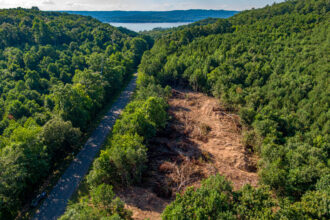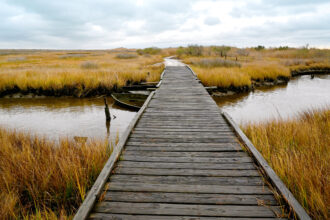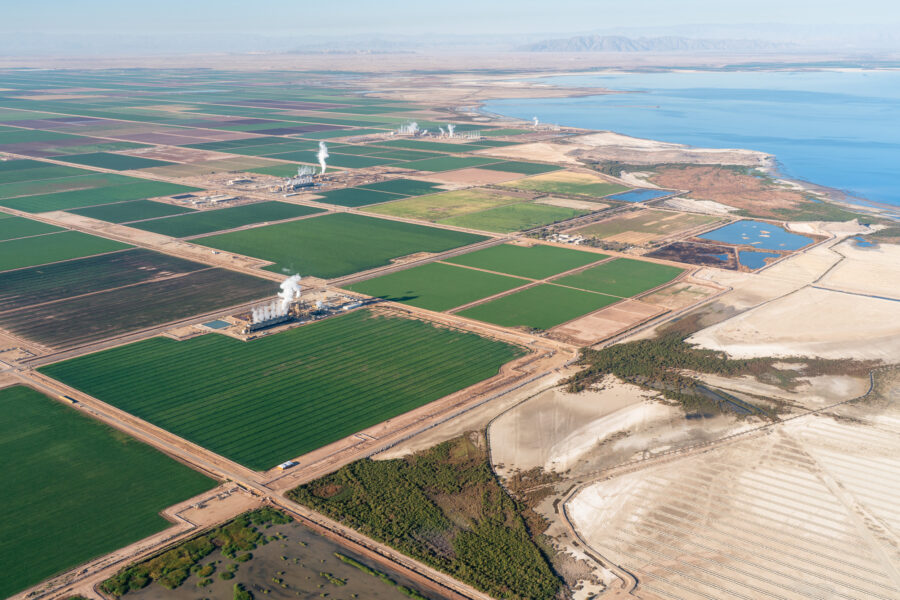OWYHEE CANYONLANDS, Ore.—Peering through a spotting scope in this remote section of eastern Oregon, Skyler Vold quietly muttered “Oh man” over and over.
In his sight was an open clearing surrounded by rolling hills of sagebrush where 22 greater sage-grouse males performed their famed and elaborate mating rituals. Every year, the sage-grouse come to locations like these, called leks. In these communal breeding grounds, males waddle around and pop their inflatable white neck pouches to reveal their inner yellowish-brown air sacs while making a cooing sound audible from a distance, all in an attempt to court a mate. It was too late in the mating season for the dancers to have much luck that morning, with most females already laying eggs, and by 8 a.m., they had returned to their homes among the brush from which they derive their name.
The 22 males spotted were the most ever recorded at the site, according to Vold, the sage-grouse conservation coordinator with the Oregon Department of Fish and Wildlife. It’s one of the country’s last strongholds of sagebrush, a landscape that is rapidly disappearing due to climate change, invasive species, human development and wildfires that are growing bigger and hotter.
“Their populations currently are a fraction of what they used to be,” Vold said.
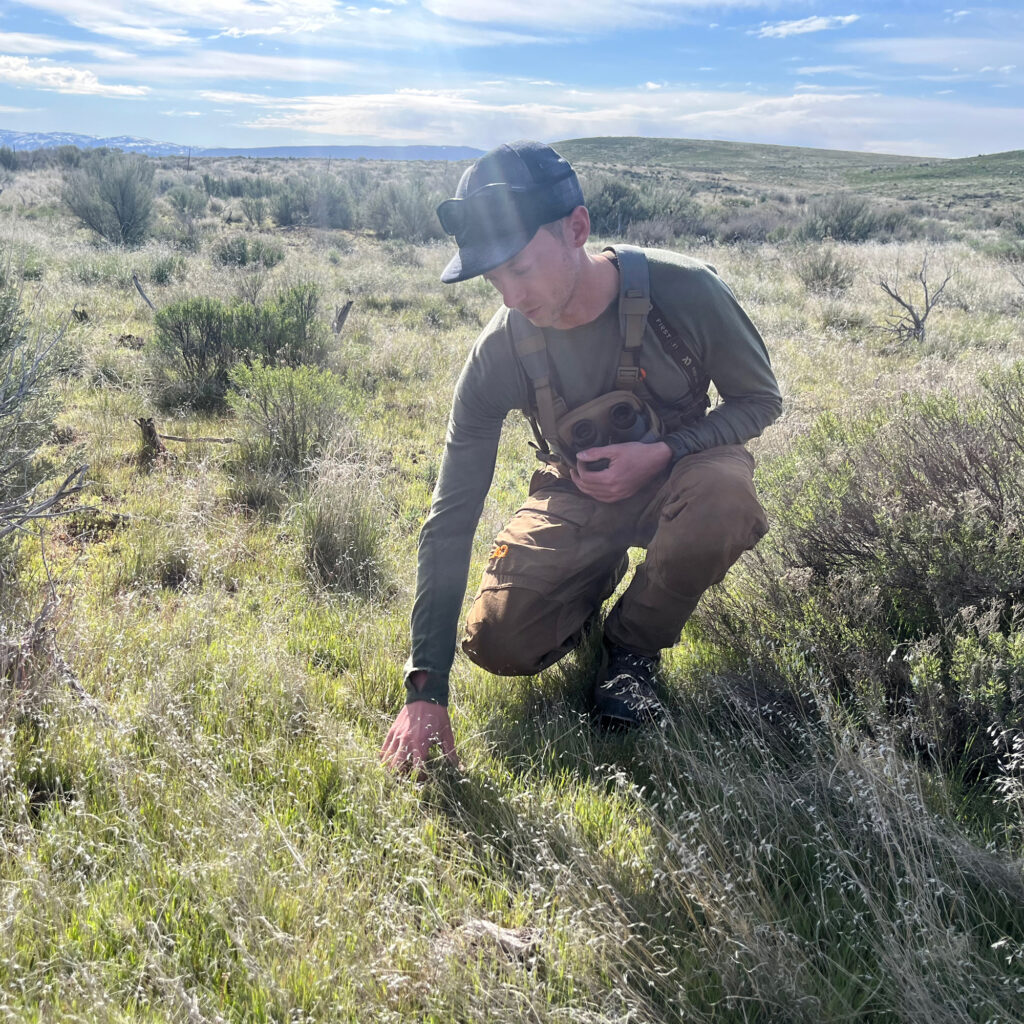
Sagebrush is vital to their survival, serving as shelters in which they nest and raise their young, and a food source in the winter, when snow often covers every other plant. The bird’s gut has evolved to remove toxins from the leaves, miraculously allowing them to have incredibly high survival rates despite the harsh conditions.
Roughly 1.3 million acres of sagebrush landscape are lost every year. And while millions of sage-grouse once filled the West across 11 states, their population has plummeted by 80 percent since 1965, according to federal government data.
For decades, groups have petitioned to have the sage grouse listed as endangered by the U.S. Fish and Wildlife Service, and in 2010, USFWS determined a listing was warranted but in 2015, the secretary of the interior announced the species did not meet the criteria to be listed because of a management plan finalized that year to protect the bird.
Since then, however, the plan to manage the bird has been in limbo, with multiple lawsuits and changing presidential administrations with different views on conservation stalling its implementation and forcing decision-makers to repeatedly return to the drawing board. Protecting the bird while also supporting economic development like oil gas drilling, cattle grazing and mining throughout the vast region where greater sage grouse are found has turned into one of the most challenging land management issues confronting Western states and the Interior Department in recent decades. As development of a coordinated regional management plan has stalled for nearly a decade, each state has been left to manage its population largely independently, with mixed results.
Now, the Bureau of Land Management—the nation’s largest landowner, which oversees most sage-grouse habitat—has proposed a plan to manage the bird’s habitat in areas it manages as the Biden administration races to finalize programs to better prioritize conservation on public lands that will drastically change how public lands in the U.S. are managed.
“The majesty of the West and its way of life are at stake. Sagebrush lands are places where people work and play, and they are the headwaters for the West’s major rivers,” said BLM Director Tracy Stone-Manning in a statement announcing the plan in March. “Joint efforts to conserve the greater sage-grouse and its habitat led to the largest collaborative conservation effort in our history, and we are building on that work, together with our partners, to ensure the health of these lands and local economies into the future.”
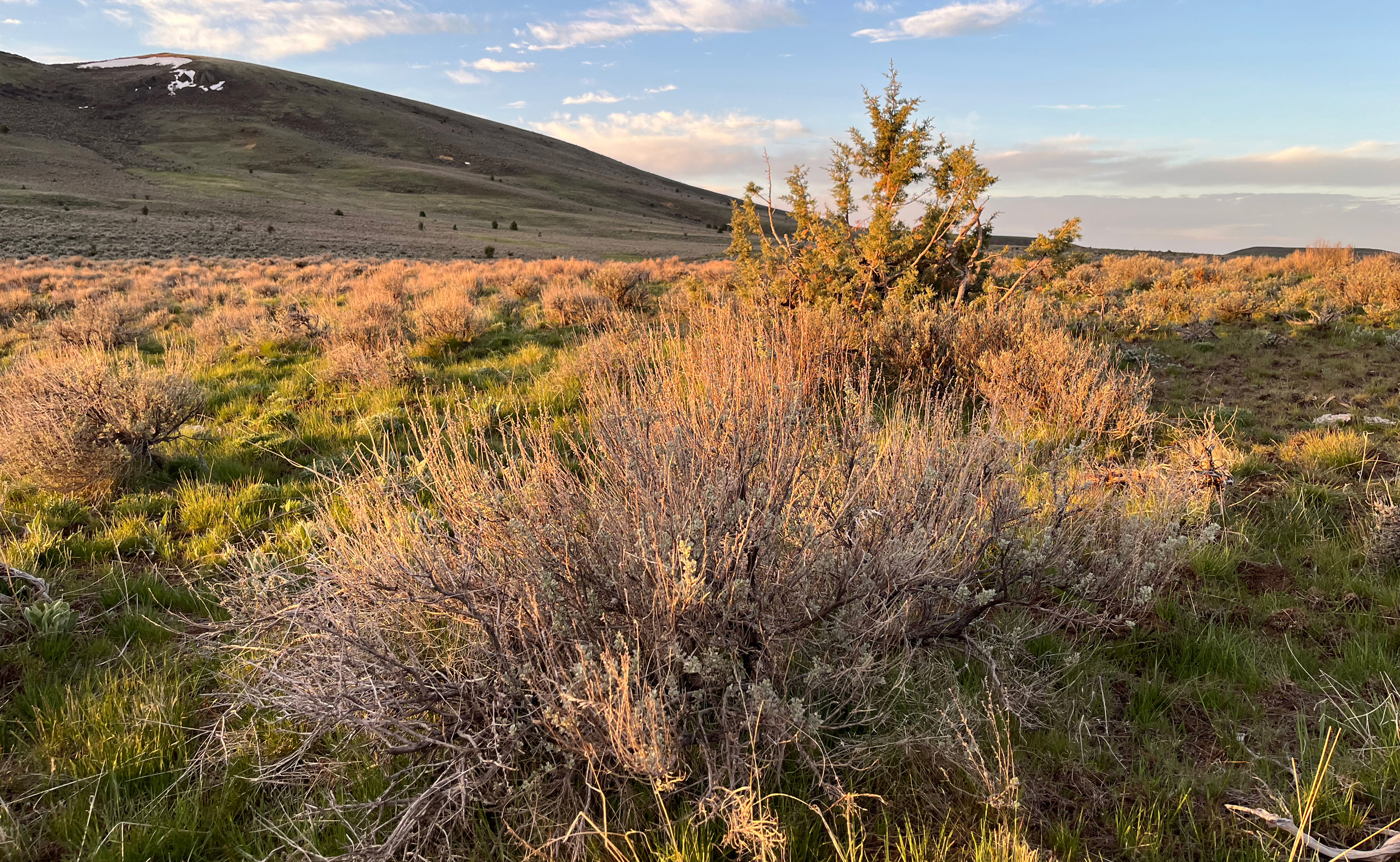
Under the federal agency’s preferred plan, roughly 35 million acres of BLM lands across 10 states would be designated as priority habitat areas, with strict protections, and another roughly 24 million acres would be designated as general habitat areas, with lesser protections. The plan would allow local flexibility, depending on the needs and interests of each state. The final deadline to comment on the draft environmental impact statement was June 13.
But if plans continue to stall, the sage grouse could end up listed under the Endangered Species Act (ESA)—something few residents of its range want as it will bring more federal oversight and restrictions, and preclude locals from finding a solution to protect the bird on their own terms.
“We’re really concerned about conservation” in Oregon, Vold said. “If there is a listing for the species, we’re all in big trouble.”
An Umbrella Species
Across their entire lifecycle, the species is reliant on every habitat type in the region, said Christian Hagen, an associate professor at Oregon State University who studies sage grouse and their habitat (Hagen also used to have Vold’s job). That means the bird’s health can act as an indicator for how the entire ecosystem is doing, he said, what’s known as an “umbrella species.” If the sage grouse is struggling, so too are the plants that make up its habitat, and the other animals found within it, like mule deer, pronghorn and rabbits.
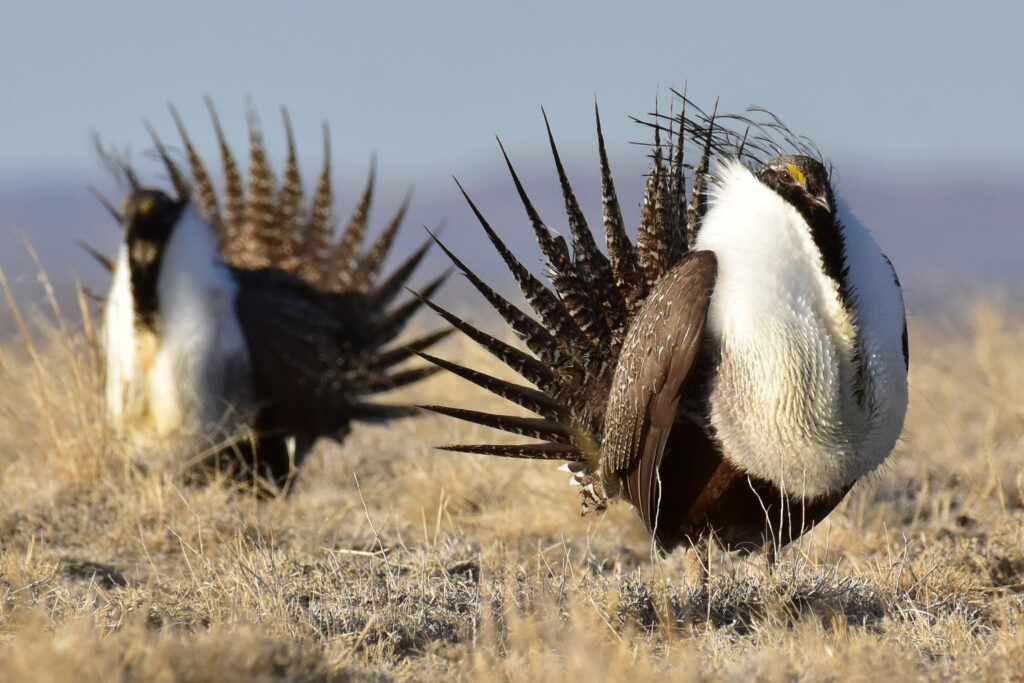
At the end of the day, he said, it’s all about the health of the landscape. “Removing or degrading habitat is the problem,” Hagen said.
Drivers of that problem run from decisions about how to use land, such as for cattle grazing, oil and gas drilling and renewable energy development, to climate change impacts, such as drought and wildfires, with each state across the sagebrush ecosystem having a slightly different mix of problems. Hagen said in Oregon, for example, wildfires driven by climate change and invasive grasses are the dominant driver of habitat loss, while in Wyoming it’s development in sagebrush ecosystems.
Across the federal lands found in the Western U.S., much of the landscape remains available for development. Public lands use is guided by the Federal Land Policy and Management Act of 1976, which mandates a multi-use strategy for the 245 million acres of land overseen by the BLM, leaving the federal agency to determine the best use of each parcel—no easy task as the agency balances conservation, recreation and extraction.
So across much of the West, the public lands where sage grouse live have often been open for development of mines and oil and gas drilling. Increasingly, they’re also under threat from renewable energy projects, like solar farms, with the BLM currently reviewing a plan to streamline solar development on public lands across 11 states.
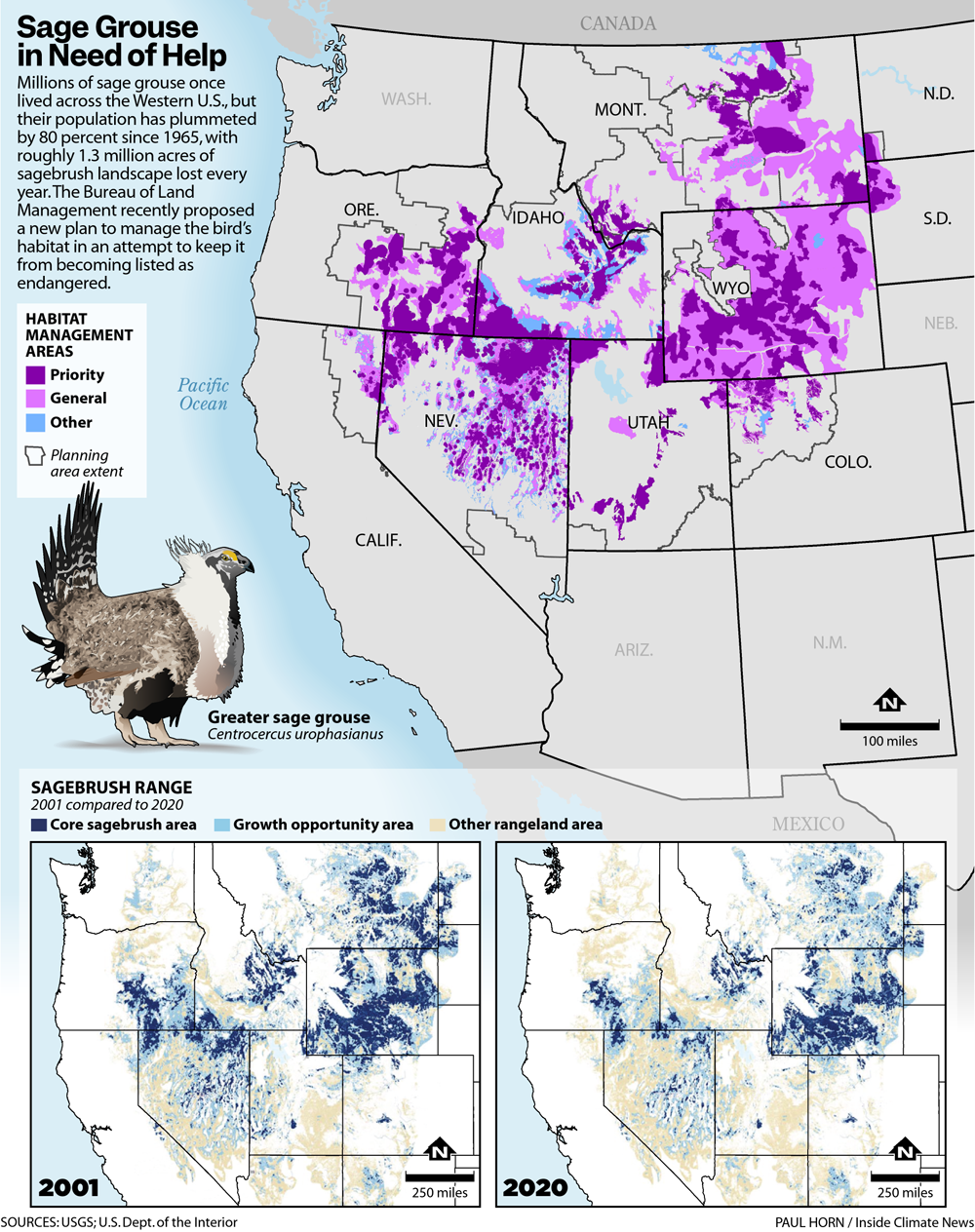
But just the noise from nearby work can impact the birds.
“We’re at a juxtaposition where we need renewable energy to fight the climate crisis, but we also need to be very cognizant of the impacts that renewables have on the ground,” said Alison Holloran, executive director of Audubon Rockies and a vice president of National Audubon Society who is involved in sage grouse management discussions for the conservation and birding advocacy group. “How are we going to manage that? It’s just not oil and gas, it’s just not mining. It’s the whole kit and caboodle when it comes to impacts on the ground.”
On top of its proposed sage grouse management plan, the BLM has proposed a new rule to put conservation on equal footing with other land uses, a decision celebrated by environmentalists. Holloran said she is optimistic the rule, which has faced pushback from energy developers and ranchers, will help balance out the needs of development and protect landscapes and species, while better determining what places are best suited for development and which aren’t.
Lack of Action Could Be Bird’s ‘Death Nail’
Not far from the sage grouse leks in the Owyhee Canyonlands—the biggest conservation opportunity left in the lower 48—the land displays a startling contrast.
Where the Danner Loop fire burned through the area in 2012, the land hasn’t recovered, despite having more than a decade to regrow. The dead bases of the sagebrush scattered across the landscape look like nothing more than gray pieces of wood planted in the ground. Invasive weeds like cheatgrass and medusahead, a succulent with green snake-like branches that extend from its base to grow yellow flowers, are everywhere, leaving little room for native plants.

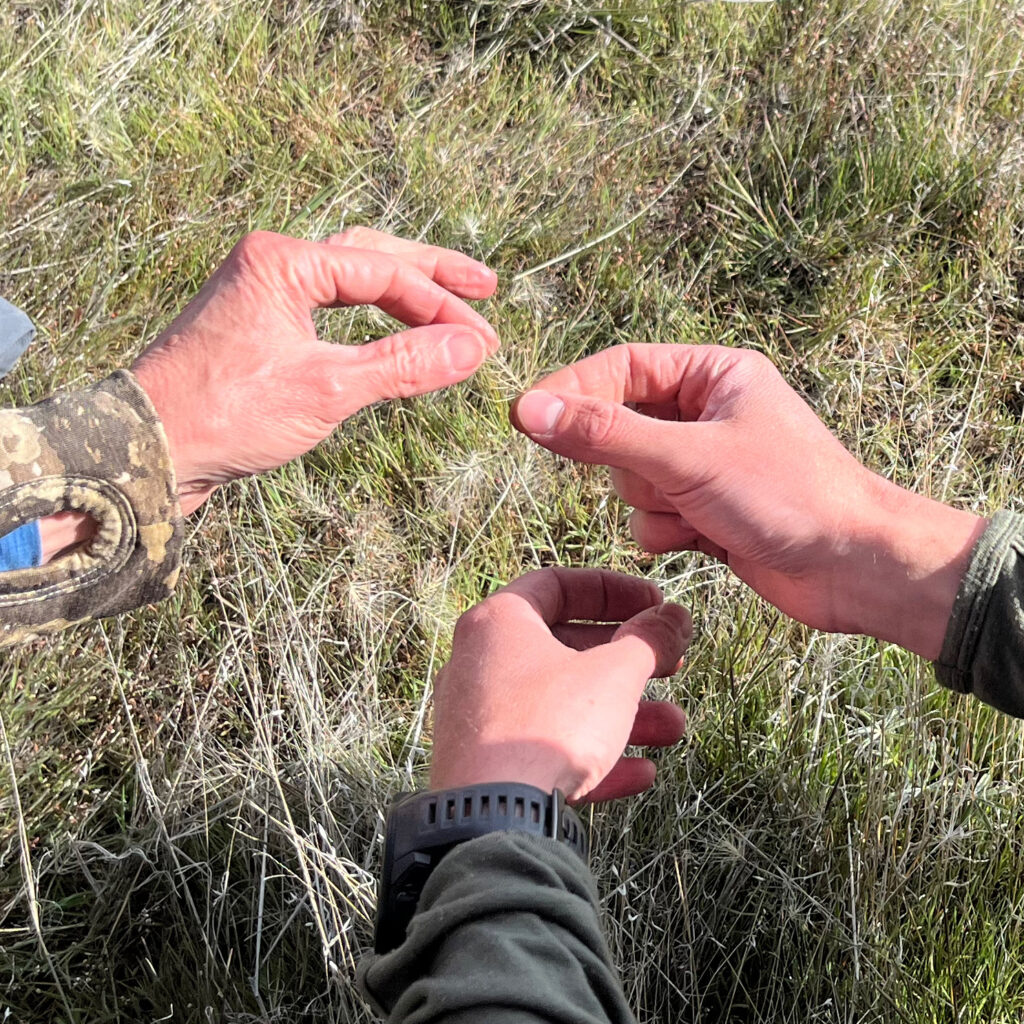
Each step through the burn scar makes a crunching noise, signaling how much dryer the soil is compared to the pristine sections of habitat nearby.
It’s a harbinger of what’s to come if the area is not better protected and given resources to fund wildfire and habitat loss mitigation efforts. In Oregon, wildfires and invasive species are the biggest threats to sagebrush habitat, each fueling the other in a vicious circle.
Vold, with Oregon Fish and Wildlife, said the invasives green earlier than native plants, out-competing them for water, and then dry out earlier, fueling hotter wildfires that have grown far larger in recent years. “Cheatgrass is so prolific, it comes in and wipes everything out,” he said.
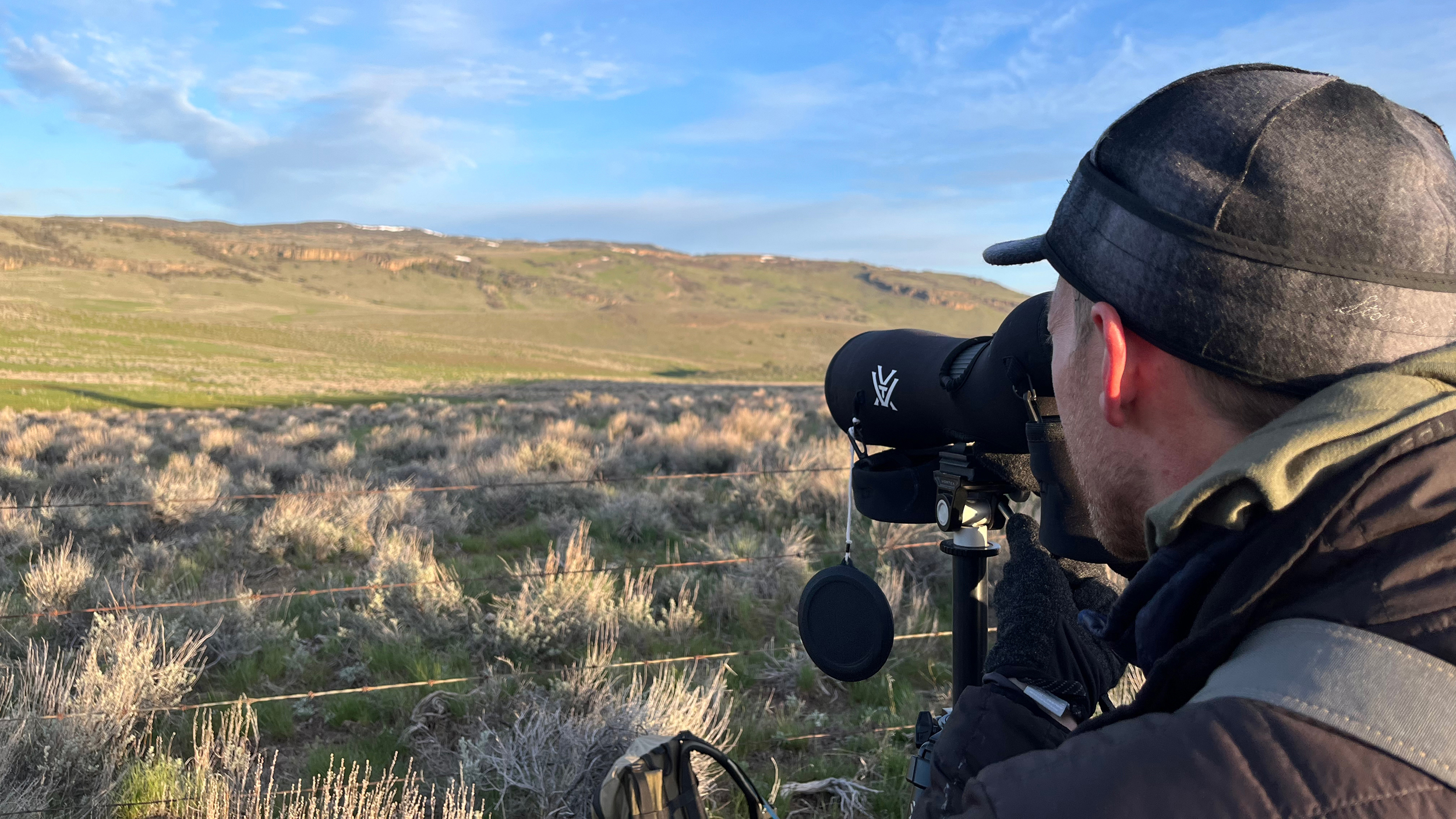
A large coalition is working to have President Joe Biden declare sections of the Owyhee Canyonlands a national monument by the end of the year. The proposal is to protect the portions of the landscape that are still pristine, preventing them from turning into something like the burn scar, said Aaron Kindle, the director of sporting advocacy at the National Wildlife Federation, who has helped lead the conservation group’s involvement in the monument push.
“You’re reducing a lot of the viability for a lot of critters” as habitat degrades, he said.
But time is running out to come up with a plan to manage the sage grouse across its entire range with an agreement that open the door for federal funding to help the bird while maintaining local control. That’s something that’s important in Oregon, which wants to give residents around the sagebrush habitat more flexibility to manage the land, Vold said.
This story is funded by readers like you.
Our nonprofit newsroom provides award-winning climate coverage free of charge and advertising. We rely on donations from readers like you to keep going. Please donate now to support our work.
Donate NowIf the sage grouse was to be listed as an endangered species, any plan would need to go through a section 107 consultation under the ESA, Hagen said, meaning any effort to manage the bird or development that could impact its habitat—no matter how big or small—would go through a lengthy and often expensive review process. “It’s not trivial at all,” Hagen said.
Holloran, who is on a sage grouse task force for Wyoming, said bird conservationists, energy developers, ranchers and officials understand what is at stake, and she’s optimistic that they can come to an agreement on a management plan.
“The worst thing that can happen is we have further litigation,” she said.
The inability to act, whether from litigation or another change in administration next year, she said, “will be the death knell for the bird.”
About This Story
Perhaps you noticed: This story, like all the news we publish, is free to read. That’s because Inside Climate News is a 501c3 nonprofit organization. We do not charge a subscription fee, lock our news behind a paywall, or clutter our website with ads. We make our news on climate and the environment freely available to you and anyone who wants it.
That’s not all. We also share our news for free with scores of other media organizations around the country. Many of them can’t afford to do environmental journalism of their own. We’ve built bureaus from coast to coast to report local stories, collaborate with local newsrooms and co-publish articles so that this vital work is shared as widely as possible.
Two of us launched ICN in 2007. Six years later we earned a Pulitzer Prize for National Reporting, and now we run the oldest and largest dedicated climate newsroom in the nation. We tell the story in all its complexity. We hold polluters accountable. We expose environmental injustice. We debunk misinformation. We scrutinize solutions and inspire action.
Donations from readers like you fund every aspect of what we do. If you don’t already, will you support our ongoing work, our reporting on the biggest crisis facing our planet, and help us reach even more readers in more places?
Please take a moment to make a tax-deductible donation. Every one of them makes a difference.
Thank you,








